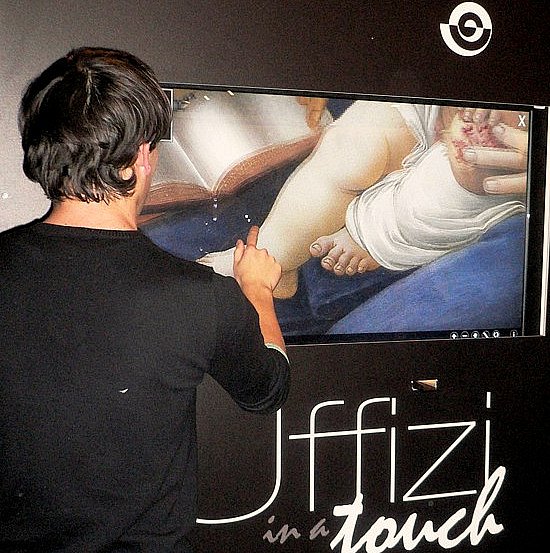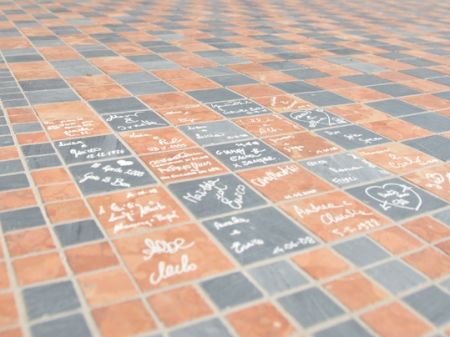Map heads all know about Piri Reis, Turkey’s mysterious master cartographer.
Now his 1513 world map stars in the full-page color advertisement below taken out in the September 21, 2017 national edition of The New York Times.

Map heads all know about Piri Reis, Turkey’s mysterious master cartographer.
Now his 1513 world map stars in the full-page color advertisement below taken out in the September 21, 2017 national edition of The New York Times.

The Italian government recently passed a series of strict new driving laws that will affect locals and tourists on the roads in the Bel Paese.
A few of the new rules to keep in mind:
As far as I know, the complete law hasn’t been published in English yet. The Transport Ministry has a complete list of all the articles in the law, you could do worse than use Google Translate on it meanwhile.
Photo used with a Creative Commons license, thanks to cruelgargle on flickr.
Pilgrims trekking Italy to ogle the the Shroud of Turin, on public display for the first time in a decade, now have iPhone apps to help them see more.
Last time thousands of visitors flocked to peek at the yellowed cloth said to depict the face of Jesus, the best mobile option was probably some lame WAP browser.
This time around, iPhone apps can help negotiate the challenges of Italian travel — opening hours, monuments off the grid — with the flick of a finger.
iSindone (“sindone” is Italian for holy shroud) costs $0.99, and offers opening times, directions for getting there and info on the cathedral. There’s also a hi-res image of the shroud, rumored to be a medieval fake, which may give you a better look than the quick drive-by visitors get of the real thing.
Instant Turin, gratis for the next two weeks in honor of the shroud unveiling, promises to steer you clear of restaurants with dreaded tourist menus and get you to the Mole on time.
The official app, also called Sindone, costs $3.99, and promises to help keep your stay organized and running smoothly.
And, if you need to walk off the chocolate and Barolo, try the sprawling gardens of Venaria Reale outside Turin — just remember to get bus times and hours handy or printed out or you will risk getting stranded.
If you’re short on cash but with some kind of marketable skill — photography, a foreign language, accounting — a Milan bed and breakfast just may be the ticket.
At Bed & Breakfast Porta Garibaldi in central Milan you can trade your talents for a place to sleep year round. The idea is the brainchild of owner Alessandra Maggioli, who also lets the studio apartment which can sleep a couple or two singles for 90 to 130 euros a night pictured above. So far Maggioli has accepted a case of good wine for a weekend, a painting by a young artist and another guest is helping her design a web site.
If you don’t need a place to crash in Milan but would like to barter plan ahead: there’s a whole circuit of Bel Paese B&Bs that for one week a year accept trades instead of cash. This year it falls from November 15-21, you can check out offers on the website.
Smart swappers may want to stay where it’s warmer or where there’s something nearby to do — nothing worse than a seaside town shut down for fall — but the idea is a good one.
An easy swap that comes to mind would be a quick, accurate translation of individual B&B websites in English or other languages.

Hands on with a chubby Christ child. @centrica
If you’ve ever stared at a painting and wanted to reach out and squeeze that adorable little putto, you’ll soon have a chance to do it without getting arrested.
Florence’s Uffizi Gallery, one of the largest treasure troves of Renaissance art, is developing a touch-screen device that allows art lovers to zoom in for a more hands-on approach to the masterpieces.

Italian art, Cover Flow style. @centrica
You can flip through centuries of art the same way you scroll through your albums on iTunes.
The program is called “Uffizi in a Touch” (sadly, a name not vetted by anyone who actually speaks English) developed by an Italian company called Centrica.
It took them four years to take life-size 100-megapixel photos that will be up for perusal in December for researchers and the more tactile groups of tourists.
No word yet on whether Apple will be after them for using the Cover Flow technology that’s been on the Cupertino company’s devices since 2006.

Caravaggio’s 1609 masterpiece “Adoration of the Sheperds” is getting touched up in public — here’s how to book the free visits.
Like a lot of things worth doing in Italy, it won’t be particularly easy. Groups of 10/15 people will be allowed to watch restorers at work in Rome’s lower chamber of parliament until it is returns to pristine condition in January 2010. Visits are free, but available only Wednesday and Friday afternoons and last about 20 minutes.
Sponsored by broadband telecommunications company Fastweb, the online reservation form shows which dates are still available. (Here’s the Google translation into English, if you need it).
Ever since a restorer acquaintance let me climb up on Giambologna’s Ferdinando I de Medici statue to check out her work, I’ve tried to get a gander at restorations whenever possible, like Donatello’s David at the Bargello or at the frescoes at Santa Croce.
If you’re in Rome, it’ll be worth the trouble.

Just in time for summer vacation traffic, Trenitalia launched a one-line announcement likely to make it the butt of more jokes: the lost and found offices have been “temporarily suspended.”
With more Italians staying closer to home in belt-tightening measures this year — 73% will not leave the country, according to one poll — trains are likely to be more crowded and chaotic than usual.
No word on when the service will pick back up again — or if it will. Trenitalia suspended the service citing budget reasons, according to daily Corriere della Sera. In 2008, it held 3,800 lost items — ranging from umbrellas to dentures, surfboards to cell phones — and returned about half to their rightful owners.
Now what? It’s up to local governments.
So If you leave your camera on the Florence-Venice train or want to be a good samaritan with that found iPod, you’ll have to go to the lost and found office (ufficio oggetti smarriti) of the city you land in.
And cross your fingers.
Related stories:
Free Trains to Italian hotels

Roman police have issued a safety sheet that, while strong on common sense, makes a vacation in the Eternal City sound devoid of the merrymaking that makes Italy such a draw for tourists.
The how-to on keeping safe and enjoying Rome (surprisingly in decent English) downloadable from their website starts off by reminding tourists (and by tourists, we mean women) why they came: “Rome is a safe city and its people are welcoming,” but some of the advice they hope tourists will keep in mind is a bit of a downer.
First the useful info:
— in an emergency, call either 112 (local police) or 113 (carabinieri). (They left out the medical emergency number, 118.)
— women get a 10% taxi discount at night as yet another “pink” initiative.
— numbers for 24-hour women’s anti violence centers: (06) 5810926 or (06) 23269049.
Alas, though most of the advice is common sense, it rules out what draws many women visitors to Italy: don’t wear any flashy jewelry, drink in moderation, do not accept drinks from strangers, do not accept invitations from strangers and stick with the people you came with.
Ok, so Rossano Brazzi was never going to roofie Katherine Hepburn’s bellini (though he is shown in the “Summertime” poster staring intently at her with a large drink in hand) but has Italy become so dangerous that visitors are well advised to glare at the locals suspiciously while clutching half glasses of wine singing “O sole mio” wistfully to their American counterparts? And given the hundreds of stories, romantic and bittersweet, about foreign women in Italy, are they really expected to?
Image courtesy @ polizia di stato

It was a pleasure to return to the Venaria Reale near Turin after writing about it for the NYT about a year ago. The occasion: they’ve finished restoring an enormous exhibition space out of the former stables and greenhouse.
On this visit, all the work was done and tidy. Fortunately, the same friendly, low-key atmosphere of a magnificent place off the beaten track hasn’t changed.
Here’s what I wrote for the Wall Street Journal Europe:
About 1,300 years ago, a string of natural disasters rocked the coast off the modern-day port city of Alexandria, sending chunks of three Egyptian cities into the sea. Up from the depths after 15 years of underwater excavation by French archeologist Franck Goddio, “Egypt’s Sunken Treasures” takes visitors on a voyage back to the Ptolemaic, Byzantine, Coptic and early Islamic eras.
The 500-piece exhibit has toured several European cities, but for its Italian stop, at Turin’s Reggia di Venaria Reale, scenographer Robert Wilson designed backdrops for statues, jewelry, gold coins, ceramics and sphinxes. His theatrical settings, including a prologue with video installations of underwater excavations surrounded by graffiti-sprayed walls, are accompanied by a soundtrack put together by performance artist Laurie Anderson.
In 1996, Mr. Goddio and his team began to search for the lost cities of Herakleion and Canopus using nuclear resonance equipment. Under centuries of algae, sand and clay sediment, they made some exceptional finds. One of the show’s highlights is a pink granite statue of Nile deity Hapi; at 5.4 meters high, the round-faced god with a tray of offerings is the largest freestanding statue of an Egyptian divinity ever found. Hapi and other towering statues, including a Ptolemaic king and queen in pink granite, loom over visitors who wander through a room conceived to look like a sunken forest.
“Sunken Treasures” is the first exhibit in the newly restored stables and greenhouse of the Reggia, designed by Baroque architect Filippo Juvarra. These high-ceilinged, cavernous rooms cover nearly 5,000 square meters, but Mr. Wilson’s low, almost nocturnal lighting and the sound, which ranges from metal clinks meant to mimic the workshops where trinkets were made to swishing waves, produce an effect on the viewer similar to a post-prandial grappa, even at 11 a.m.
A welcome respite from undersea atmosphere comes in the “Sphinx Box,” a well-lit, airy room where the heads of sphinx statues are viewed through white netting. The show’s masterpiece, however, appears in the last room, aptly called Queen’s Dream. The harmonious figure of a woman draped in clinging robes is believed to be Queen Arsinoe II, sister and wife of Ptolemy II. Carved in gray-blue granite, her pose is typical of Egyptian statues, but the style of her dress is decidedly Greek.
Until May 31

Two million romantics flock to see Romeo and Juliet’s balcony every year in Verona.
Unfortunately, many of them also carve their names or scribble hearts on the monument, making it more of a tourist trap than attraction.
To stop love-struck tourists from ruining the building, managers of theater Teatro Stabile, who own the famous balcony, came up with the idea of “lovestones.”
For €100 (about $135) lovebirds have a their names (plus short message and date) carved in laser on marble tiles on a terrace below the balcony. You also get a certificate with a map and can also request copies of the tile, for €35 (about $45).
There are some 60,000 lovestones available, organizers assure that someone will be on hand to help you find yours, should you come to Verona to see it.
Love may not be eternal, but these these lovestones will last indefinitely. Or at least until the natural abrasion erodes the marble surface.
Purchase of the tiles will help modernize the 1846 theater.